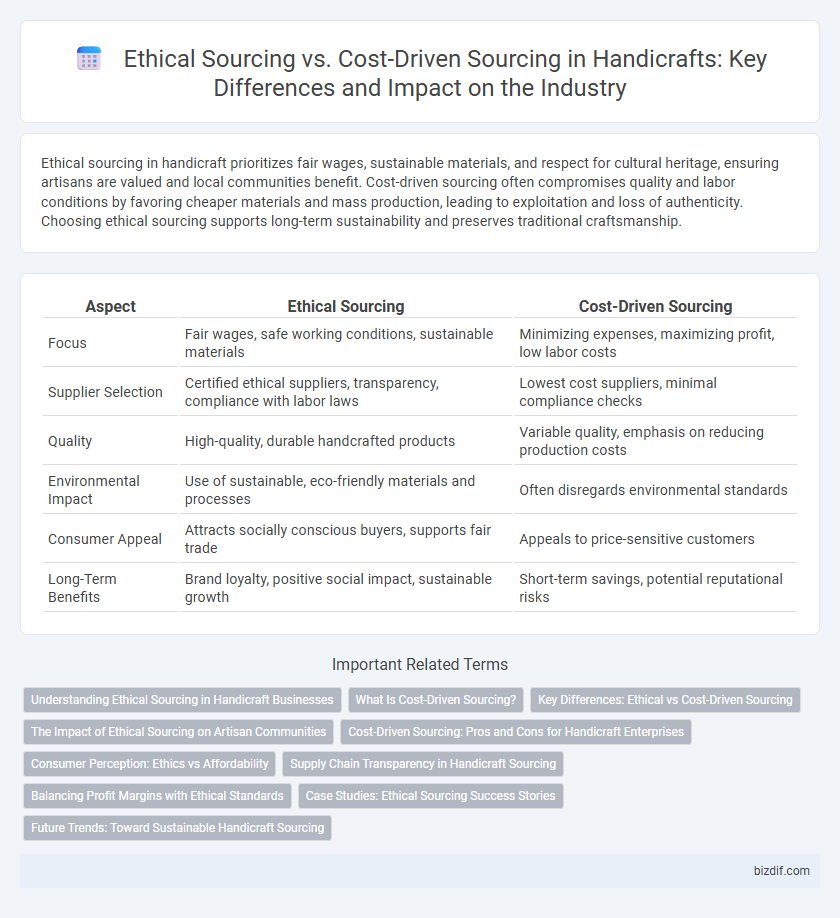Ethical sourcing in handicraft prioritizes fair wages, sustainable materials, and respect for cultural heritage, ensuring artisans are valued and local communities benefit. Cost-driven sourcing often compromises quality and labor conditions by favoring cheaper materials and mass production, leading to exploitation and loss of authenticity. Choosing ethical sourcing supports long-term sustainability and preserves traditional craftsmanship.
Table of Comparison
| Aspect | Ethical Sourcing | Cost-Driven Sourcing |
|---|---|---|
| Focus | Fair wages, safe working conditions, sustainable materials | Minimizing expenses, maximizing profit, low labor costs |
| Supplier Selection | Certified ethical suppliers, transparency, compliance with labor laws | Lowest cost suppliers, minimal compliance checks |
| Quality | High-quality, durable handcrafted products | Variable quality, emphasis on reducing production costs |
| Environmental Impact | Use of sustainable, eco-friendly materials and processes | Often disregards environmental standards |
| Consumer Appeal | Attracts socially conscious buyers, supports fair trade | Appeals to price-sensitive customers |
| Long-Term Benefits | Brand loyalty, positive social impact, sustainable growth | Short-term savings, potential reputational risks |
Understanding Ethical Sourcing in Handicraft Businesses
Ethical sourcing in handicraft businesses ensures artisans receive fair wages and work in safe conditions, promoting sustainability and cultural preservation. This approach often involves transparency in supply chains and supports community development, contrasting sharply with cost-driven sourcing that prioritizes lower expenses over social impact. Emphasizing ethical practices builds consumer trust and aligns with growing global demand for socially responsible products.
What Is Cost-Driven Sourcing?
Cost-driven sourcing prioritizes minimizing expenses by selecting suppliers based primarily on the lowest price, often overlooking factors like fair labor practices and environmental impact. This approach can lead to compromised quality and ethical concerns, including poor working conditions and unsustainable material use. In the handicraft industry, cost-driven sourcing may undermine the craftsmanship's authenticity and the artisans' livelihoods by favoring mass-produced, inexpensive materials over ethically sourced, high-quality components.
Key Differences: Ethical vs Cost-Driven Sourcing
Ethical sourcing in handicrafts prioritizes fair wages, sustainable materials, and transparent supply chains, ensuring artisans' welfare and environmental responsibility. Cost-driven sourcing focuses on minimizing expenses, often compromising product quality and ethical labor practices to achieve lower prices. Key differences include the impact on craftsmanship integrity, long-term brand reputation, and the socio-economic benefits for artisan communities.
The Impact of Ethical Sourcing on Artisan Communities
Ethical sourcing prioritizes fair wages, safe working conditions, and sustainable materials, directly improving the livelihoods and well-being of artisan communities. This approach fosters long-term economic stability and preserves traditional craftsmanship by valuing cultural heritage and empowering local artisans. In contrast, cost-driven sourcing often exploits labor and depletes resources, undermining the social and economic fabric of these communities.
Cost-Driven Sourcing: Pros and Cons for Handicraft Enterprises
Cost-driven sourcing in handicraft enterprises emphasizes minimizing expenses to maximize profit margins, often leading to lower production costs by selecting cheaper materials and labor. While this approach can improve short-term financial performance and competitive pricing, it risks compromising product quality, artisans' welfare, and brand reputation. Over time, reliance on cost-driven sourcing may undermine sustainable growth due to reduced consumer trust and ethical concerns in the handicraft market.
Consumer Perception: Ethics vs Affordability
Consumer perception in handicraft purchasing often balances ethical sourcing with affordability, where ethically sourced products are valued for fair labor practices and sustainable materials but may come at a higher price point. Cost-driven sourcing appeals to price-sensitive buyers seeking budget-friendly options, potentially compromising on ethical standards. This tension influences buying decisions, with a growing segment prioritizing transparency and craftsmanship over cost, reflecting increasing awareness of social and environmental impacts.
Supply Chain Transparency in Handicraft Sourcing
Supply chain transparency in handicraft sourcing ensures ethical practices by providing full visibility into the origin and production processes, enabling fair wages and sustainable materials. Ethical sourcing prioritizes artisan welfare and environmental impact over lower costs, fostering long-term community development. Cost-driven sourcing often compromises transparency, risking exploitation and quality degradation in pursuit of minimal expenses.
Balancing Profit Margins with Ethical Standards
Balancing profit margins with ethical standards in handicraft sourcing requires prioritizing fair labor practices, sustainable materials, and transparent supply chains without compromising product quality. Ethical sourcing often involves higher upfront costs but builds brand trust, customer loyalty, and long-term sustainability, contrasting with cost-driven sourcing that may lower expenses but risks reputational damage and exploitative labor. Integrating certifications like Fair Trade or B Corp and collaborating with local artisans ensures a responsible supply chain that aligns profit goals with social and environmental accountability.
Case Studies: Ethical Sourcing Success Stories
Ethical sourcing in handicrafts highlights success stories such as the collaboration between Ten Thousand Villages and artisans in Nepal, which improved community livelihoods while maintaining fair wages and sustainable practices. Case studies from Indian handloom cooperatives demonstrate how transparent supply chains and ethical labor standards foster empowerment and preserve traditional crafts. Brands embracing ethical sourcing often experience increased customer loyalty, stronger brand reputation, and long-term economic benefits for the artisan communities.
Future Trends: Toward Sustainable Handicraft Sourcing
Future trends in handicraft sourcing emphasize ethical practices that prioritize artisans' welfare and environmental sustainability over cost-driven decisions. Increasing consumer demand for transparency and fair trade certifications drives brands to adopt sustainable supply chains that reduce ecological impact while supporting local communities. Innovations in blockchain technology and eco-friendly materials are shaping a new era where authenticity and responsibility define handicraft procurement.
Ethical Sourcing vs Cost-Driven Sourcing Infographic

 bizdif.com
bizdif.com